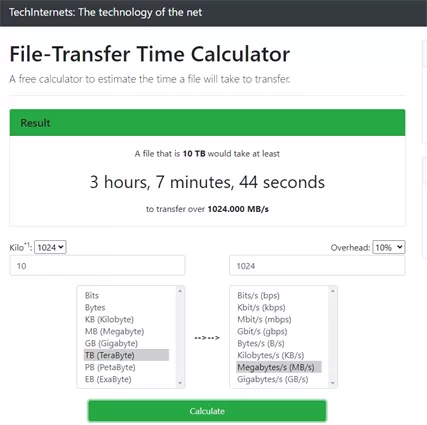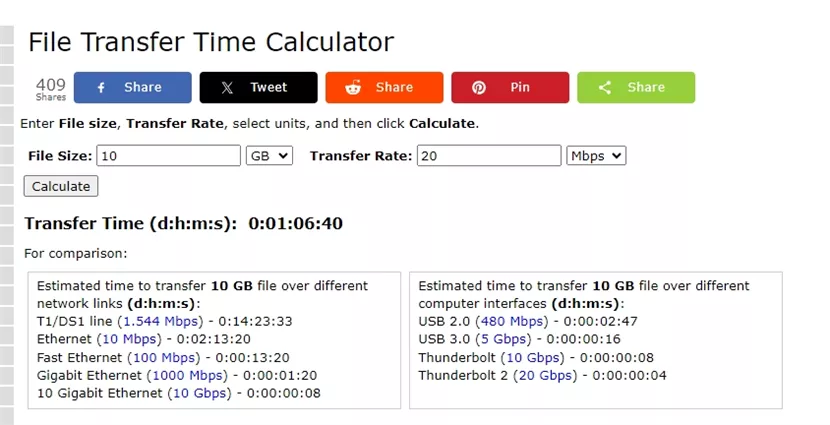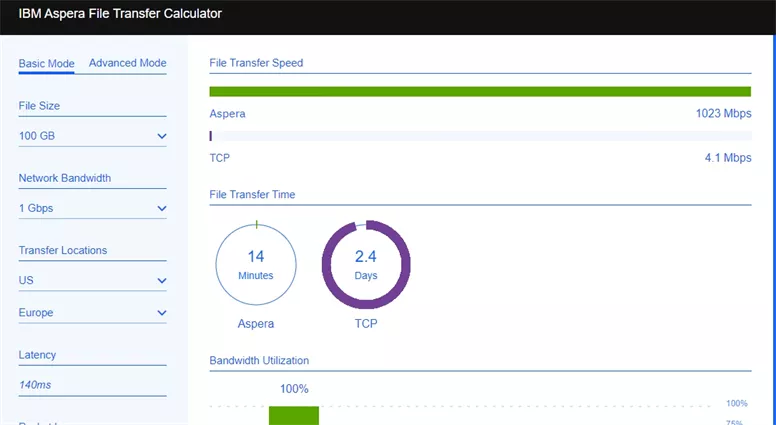Everything about File Transfer Calculator You Should Know
July 4, 2024This article is your friendly guide for effectively using a file transfer calculator to streamline data transfer planning. We will help you explore how to input key variables like file size, bandwidth, and network conditions into calculators like TechInternets, WintelGuy, IBM Aspera, and Raysync.

What Is File Transfer Calculator
A File Transfer Calculator is a specialized tool designed to estimate the time required to transfer files between devices or over networks based on numerous parameters.
These calculators consider factors like file size, available bandwidth, and network latency to provide accurate predictions of transfer durations.
By inputting these variables, users can anticipate transfer times and plan accordingly, optimizing efficiency and resource allocation.
File transfer speed calculator is invaluable for IT professionals, network administrators, and individuals needing to manage large-scale data transfers effectively.
Utilizing such calculators enhances productivity by offering insights into the intricacies of data transfer logistics.
9 Factors will Affect File Transfer Speed
There are several factors that can significantly influence file transfer speed:
- Network Bandwidth: The available bandwidth determines how much data can be transferred at a given time.
- Latency: Network latency, or the delay between sending and receiving data, impacts transfer speed, especially over long distances.
- Protocol Overhead: The additional data transmitted for protocol headers and error checking can reduce effective transfer rates.
- Network Congestion: Heavy network traffic can slow down transfers by limiting available bandwidth.
- Hardware Limitations: Older or less powerful hardware may bottleneck transfer speeds.
- File Size: Larger files take longer to transfer than smaller ones, impacting overall transfer time.
- Encryption: Encrypting data adds processing overhead, affecting transfer speeds.
- Distance: Physical distance between sender and receiver can affect latency and transfer rates, especially in global transfers.
- Packet Loss: Network packet loss requires retransmissions, slowing down transfers and reducing efficiency.
Best 4 File Transfer Calculators Recommended
In this section, we will look at the top file transfer calculator that streamline data transmission planning to optimize efficiency across diverse scenarios.
1. TechInternets File-Transfer Time Calculator
TechInternets features a solid file transfer time calculator designed for quick estimates using parameters such as file size, and network conditions.
This user-friendly tool offers valuable insights into optimizing file transfers across diverse environments, ranging from local networks to cloud infrastructures.
It helps users plan efficiently by providing accurate estimates of transfer times, ensuring effective management of data across different systems and platforms.

2. WintelGuy File Transfer Time Calculator
WintelGuy's file transfer speed calculator emphasizes network bandwidth and latency to provide detailed projections for optimizing data movement efficiency. It is a bandwidth calculator file transfer.
It enables precise calculations that aid in strategizing and implementing efficient data transfers across various network environments, ensuring seamless performance and enhanced operational productivity.

3. IBM Aspera File Transfer Calculator
IBM Aspera file transfer calculator is designed for high-speed data transfers, utilizing its proprietary FASP® protocol. It calculates transfer times across global networks, taking into account critical factors such as latency and packet loss.
This ensures swift and secure data exchanges, particularly beneficial for enterprises dealing with substantial data volumes.
The calculator empowers organizations to plan and execute efficient data transfers, optimizing performance across diverse network conditions and geographical locations.

4. Raysync Cross-continental File Transfer Calculator
Raysync has its own file transfer calculator that estimate the time of cross-continental data transfers.
This tool provides accurate estimates of transfer times while ensuring solid data integrity, essential for industries that demand swift and dependable global data synchronization and distribution.

How to Use File Transfer Calculator
Using a File transfer calculator is a super simple process and with tools like Raysync that come with a user-friendly interface, it becomes a matter of just a few clicks.
- Step 1. Navigate to the Raysync Calculator.
- Step 2. Enter Source and Destination: Specify the source location and the destination.
- Step 3. Input File Size: Enter the size of the file you intend to transfer.
- Step 4. Bandwidth: Specify the bandwidth of your internet connection,
- Step 5. Calculate: Click on the calculate button or equivalent to generate the estimated transfer time with using Raysync .
The Bottom Line
Whether you are beginning your file transferring journey today or are ready to it up, mastering a file transfer calculator like Raysync will help you with efficient data management and transfer planning. These tools empower users to predict transfer times accurately, optimize workflows, and ensure smooth data exchanges across diverse environments. Integrating these calculators into your toolkit enhances productivity and streamlines operations.
You might also like

Industry news
June 13, 2024Discover the top 5 enterprise managed file transfer solutions. Compare features, pricing, and user reviews to find the best fit for your business needs.

Industry news
December 12, 2025Learn why upgrading bandwidth doesn’t solve slow global file transfers and how latency plus protocol inefficiencies limit speed. Discover how Raysync’s UDP-based acceleration maximizes bandwidth and overcomes long-distance transfer bottlenecks.

Industry news
August 29, 2024Discover the top 5 enterprise secure FTP solutions to elevate your business.